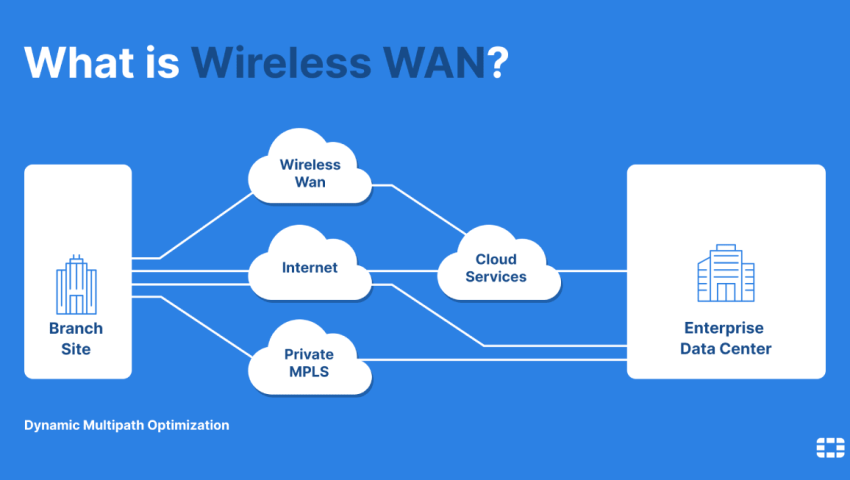
Fortinet SD-WAN
What is Fortinet SD-WAN? A Software-Defined Wide Area Network (SD-WAN) is a networking technology that leverages software-defined networking (SDN) principles to enhance WAN performance. SD-WANs provide secure, reliable, and scalable connectivity across various locations while centralizing management and visibility over the network.
Why is SD-WAN important?
SD-WAN technology is important as it enhances network performance across wide area networks and offers better performance, increased security, and flexibility. SD-WANs optimize data flow based on current network conditions, application needs, and pre-defined policies, allowing greater control without sacrificing performance or incurring high costs. The key benefit of SD-WAN technology is that it can identify the best possible routes for traffic, and this simplification improves overall speed and service quality.
Key Components of SD-WAN
SD-WAN architectures include several key components that work together to deliver optimized and secure connectivity. Following are the key components of SD-WAN
Embedded Firewall: An embedded firewall is directly integrated into the SD-WAN device, providing essential security functions without the need for additional hardware.
Firewall Embedded with SD-WAN: This configuration tightly couples the firewall with the SD-WAN functionality, enabling streamlined security policy management and enforcement.
SD-WAN with Secure Web Gateway (SWG): Integrating SD-WAN with a secure web gateway adds advanced threat protection and content filtering to control web traffic and prevent malicious activity.
SD-WAN with Third-Party Firewall: This approach allows organizations to leverage their existing firewall investments while benefiting from SD-WAN's connectivity and optimization capabilities.
Benefits of SD-WAN
SD-WAN offers an alternative to traditional WAN architectures, delivering significant advantages in performance, security, and cost-efficiency. By intelligently routing traffic across a mix of connections like broadband internet, MPLS, and LTE, SD-WAN optimizes network resources. This translates to faster application performance, improved productivity, and greater business agility. Some of its key benefits are:
Improved network performance
SD-WAN prioritizes business-critical applications, ensuring optimal performance and minimal latency.
It dynamically adjusts traffic flows based on real-time network conditions, maximizing bandwidth utilization.
This results in a smoother and more responsive experience for users, regardless of their location.
Enhanced security
SD-WAN incorporates advanced security features like next-generation firewalls, intrusion prevention systems, and secure web gateways.
It enables secure segmentation of the network, isolating sensitive data and applications from potential threats.
This comprehensive approach strengthens the security posture and protects against evolving cyberattacks.
Cost efficiency
SD-WAN reduces reliance on expensive MPLS circuits by leveraging cost-effective broadband internet connections.
It optimizes bandwidth utilization, minimizing the need for costly upgrades.
This leads to significant cost savings without compromising performance or security.
Centralized management
SD-WAN provides centralized control and visibility over the entire network, simplifying management and configuration.
Administrators can easily define and enforce policies, monitor performance, and troubleshoot issues from a single interface.
This streamlines operations and reduces the burden on IT staff.
Scalability and flexibility
SD-WAN allows businesses to easily scale their network up or down as needed, accommodating growth and changing demands.
It supports a wide range of connectivity options, providing flexibility to adapt to different environments and requirements.
This ensures the network can evolve with the business, supporting new initiatives and enabling digital transformation.
Why is Intergrated SD-WAN Security Critical?
One of the critical requirements for SD-WAN success is fully integrated security. Without it, SD-WAN becomes just another attack vector.
A secure SD-WAN solution is explicitly designed to interoperate as a single offering, ideally with each element running on the same operating system and managed using a single-pane-of-glass interface. This ensures that transactions are all seen and inspected, and any threats or anomalous behaviors are shared between every solution for maximum protection. As part of such an integrated monitoring system, the networking and connectivity functionalities of an SD-WAN aren’t just more closely associated with the security solutions installed on the platform. They’re the same thing.
Deployment of security piecemeal is also unwise. Because of the dynamic nature and high scalability of SD-WAN, overlay security is not only very expensive to deploy and maintain, but often ends up with delays when reacting to connectivity changes, leaving critical connections and data vulnerable. An integrated system ensures that SD-WAN connectivity, traffic management functions, and advanced security function as a single, holistic solution.
An NGFW, whose key components include intrusion prevention (IPS), web filtering, secure sockets layer (SSL) inspection, and anti-malware, is an example of an integrated solution. Solutions that combine SD-WAN and NGFW capabilities into single offerings satisfy the key requirements for secure SD-WAN—and ensure the safety and reliability of connections and for the organization overall.
As enterprises adopt remote workforce policies, networks grow more distributed. A new networking and security strategy is required that combines network and security functions with WAN capabilities to support the dynamic, secure internet access for a “work from anywhere” global workforce. SD-WAN plays a critical role in the adoption of emerging solutions like Secure Access Service Edge (SASE) and enables flexible and consistent security across all edges.
Integrating Generative AI (GenAI) into SD-WAN
Integrating Generative AI (GenAI) into SD-WAN management marks a significant advancement in network operations. By harnessing GenAI's capacity to learn from extensive datasets and produce valuable insights, organizations can optimize and expedite various phases of the SD-WAN lifecycle.
Day 0 - Simplified Deployment: Setting up an SD-WAN traditionally involved complex configurations and manual interventions. GenAI can automate many of these tasks, analyzing network requirements and generating optimal configurations, thus reducing deployment time and minimizing errors.
Day 1 - Intelligent Operations: Managing and optimizing an SD-WAN network requires continuous monitoring and adjustments. GenAI can analyze network traffic patterns, identify potential bottlenecks, and suggest configuration changes in advance to maintain optimal performance. This intelligent automation reduces the burden on IT teams and allows them to focus on strategic initiatives.
Day 2 - Predictive Scaling: As businesses grow and evolve, their network needs change. GenAI can analyze historical data and current trends to predict future network requirements, organizations can scale their SD-WAN infrastructure in anticipation of future needs. This foresight helps prevent performance issues and keeps the network aligned with business objectives.
Incorporating GenAI into SD-WAN management equips organizations to attain heightened agility, efficiency, and cost-effectiveness. By automating routine tasks and providing intelligent insights, GenAI frees up IT resources, reduces operational complexity, and allows businesses to focus on innovation and growth.
Integrating digital experience monitoring with SD-WAN
In the modern business environment, where applications are vital, a smooth end-user experience becomes indispensable. By focusing on the end-user experience, organizations can maintain optimal application performance, leading to increased productivity, improved customer satisfaction, and a competitive advantage in the digital marketplace.
DEM captures real-time data on user interactions with applications, offering insights into factors like latency, packet loss, and jitter. By correlating this data with SD-WAN telemetry, organizations gain a comprehensive understanding of how network conditions affect the end-user experience.
This deeper visibility allows IT teams to:
Identify and troubleshoot performance issues: DEM can pinpoint the root cause of slowdowns or disruptions, whether they originate in the network, the application, or the end-user device.
Prioritize remediation efforts: By understanding how performance issues affect users, IT teams can prioritize addressing the most critical problems.
Optimize application delivery: DEM data can be used to fine-tune SD-WAN policies, guaranteeing that critical applications receive the necessary bandwidth and prioritization.
Integrating DEM with SD-WAN shifts network management from a reactive to a proactive approach. By prioritizing the end-user experience, organizations can maintain optimal application performance, resulting in increased productivity, improved customer satisfaction, and a competitive edge.

